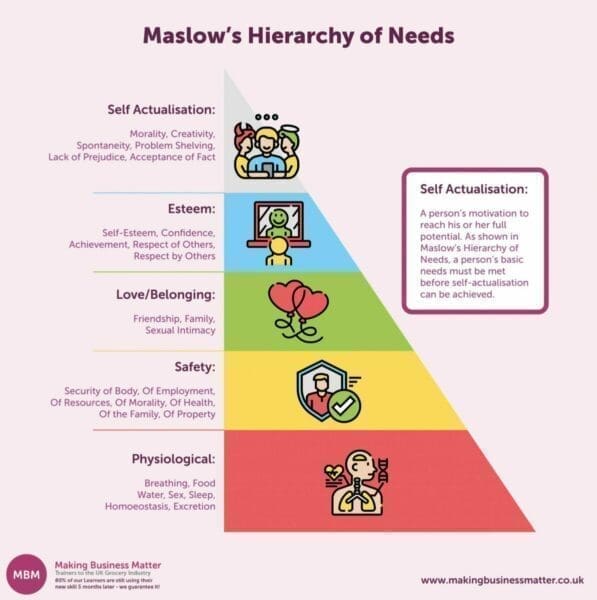We All Want and Need Motivated and Driven Team Members to Get Things Done
Staff who are motivated perform better in terms of productivity and quality of work. Without them, we will struggle to achieve any of our business results. They collaborate and communicate more effectively. Also, the work environment is nicer and there is better attendance and timekeeping. Any of us would want these elements in our workplace. But how can we make that happen? What about Maslow’s Hierarchy of Needs as an approach to use?
As our team members are all different, they have different motivators. We need to understand where our different team members are in terms of what motivates them. Otherwise, we will be trying in vain to motivate by using the wrong triggers. This is where Maslow’s hierarchy of needs comes into play. Here. we explain what Maslow’s theory is and look at the 5 different levels. Also, we look at the relevance of this theory nowadays as well as its importance in our company.
What is Maslow’s Hierarchy of Needs?
Back in 1943, Abraham Maslow introduced us to his paper on psychology: “A Theory of Human Motivation”. Here, he explained how human motivation is driven by different needs. These needs were set in a 5-tier hierarchy. A key element of the theory is that you cannot move to higher levels until lower levels are properly satisfied. So, as each level is satisfied, we move up the hierarchy with new needs to be met.
Maslow’s theory is used around the world in management training and education. Students study it as part of management curriculums. I studied it myself in college. You very often see it depicted as a layered triangle or pyramid. Some argue that the theory is dated or even flawed. However, we argue that it has great value in understanding human motivation.
When you apply it to your team, you see how different staff are at different levels at different times. With this knowledge, you then identify the right motivators to stimulate them. This, in turn, helps in achieving better company success.
Click the image below for a higher resolution.

The 5 Levels of Maslow’s Hierarchy
The 5 levels are physiological needs, safety and security, belonging and love, esteem, and finally self-actualisation. We will look at each to better understand the different levels. While we go through them, try to find your current level.
#1- Physiological Needs
Here we have the most basic human needs. They include sleep, food, water, shelter, and even air. These are the very basic needs for our very survival.
We must satisfy these needs before we can move on to others. We are demotivated and frustrated when these needs are missing. Think about the last time you were really hungry. Did you really care about anything else? Probably, you were distracted and you weren’t able to think about anything else. Once these basic needs are met, we are motivated to do other things.

#2- Safety and Security
We are motivated towards safety and security only when the physiological needs are met. However, these safety and security needs are just as important to us. These needs include health, financial, job, and physical security. For example, we want to know that our workplace is safe and we won’t get harmed or injured. We also want to be confident of receiving our salary at the end of the week or month.
Keep the following in mind:
- Secure the 1st level needs before moving on.
- Create a feeling of safety and security in your workplace.
- Share realistic information about how the company is performing.
- Acknowledge potential challenges and the steps to overcome them.
- Promote health and safety practices for everyone to follow.
Only then can we all start focusing on more lasting connections to our workplace rather than just a paycheque.
#3- Belonging and Love
We all want and need different relationships in our lives. We need our family and friends. These connections are important for us to feel wanted. They strengthen us. In terms of the workplace, we want to feel we belong to the team. Also, we want to have relationships that create an enjoyable atmosphere at work. We can often feel alienated or depressed when these needs are missing. At work, look at the following:
- Encourage team activities to get people to collaborate.
- Celebrate achievements as a group.
- Use team-building activities to enhance team-related skills.
- Recognise the strengths of all team members in the group.
- Praise in public, correct in private.
- Ensure you conduct regular team meetings to share ideas and suggestions.
#4- Esteem
We have 2 elements at this level. The first is the esteem from others. We want our colleagues and leaders to appreciate and value us. Also, we want the same from our family and friends. Everyone is motivated, to some degree, when they are recognised for their contribution.
The second is self-esteem. This is the ability to be able to appreciate our worth, even if others don’t. There are times when those around us won’t see what we have to offer. This is where self-esteem will come into play. You know the saying “you can’t please everyone”, well that applies here. Sometimes, we are motivated without the esteem of others.
What is important for this level is that we need at least one of them to be present. When neither is present, we have feelings of being useless or inadequate. We question our purpose and relevance.
#5- Self-Actualisation
This level has different meanings to each of us. For example, Mary will reach this level when she writes her first novel and sees it on the best-sellers list. Whereas, John will be at this level when he retires, has his pension, and can forget about work.

This is about knowing what is most important to you, achieving it, and the satisfaction you feel from it. Very often, we achieve this level in our lives and then move quickly again to a lower level.
So, we know the levels now. But, how do they relate these to the workplace? Something important to remember about all of these levels is that we can revisit levels at different times. Let’s have a look.
Relevance in The Workplace of Maslow’s Hierarchy
Take the very first level of needs. People are at this level when they are searching for a new job. For example, John applied for the job vacancy in your company to satisfy these basic needs. John, as a possible new hire, wants to impress during the interview to secure the job.
You hire John to join the company. Now he has moved onto the second level of safety and security. He is eager to please to complete his probation. That way his job will be secure and he can start enjoying the workplace and team environment more. Once he has started to settle in, he will start developing workplace relationships, therefore moving on to level 3.
Next, John has gained a lot of knowledge and experience on the job. He is performing really well. So, he won Employee of the Month. Now, you nominate him for development courses. Then, he moves from level 3 to level 4. His self-confidence increases and he becomes the top performer in the team.
Finally, John is promoted to manager and he’s delighted. This is what he wanted when he first joined the company. But, wait for it. John won’t stay at this level of self-actualisation in the new role. He will move to the 2nd or 3rd level. Why you might ask? Now, he needs to create job security in the new role. Also, he needs to build new relationships as a leader rather than a colleague. Then he will need to prove himself. And so, it continues. While all this is going on for John, other members of your team are moving between the levels at different times.
Motivators and Maslow’s Hierarchy
We have seen a very basic example above of the relevance of Maslow’s hierarchy in our workplace. Let’s link each level to possible motivators we can provide.
Level #1
Here is the first level of the basic needs. We, as employers, need to offer motivators that meet those needs of shelter, food, water, etc. So, we offer fair and competitive salaries when hiring. Also, we include additional benefits such as meals at work or discounts. Some companies even offer accommodation or allowances for transport. These are all examples of possible motivators at this level.

Level #2
Next, at level 2, we look at meeting the needs of job security, physical security, etc. Here, use training programmes to prepare new employees to complete their probation successfully. Also, offers a healthy and safe workplace. In addition, pay your staff fully and on time.
Level #3
For the third level of belonging, we offer interpersonal experiences. These can be anything from team training sessions to departmental meetings, to team building activities. Remember, everyone wants to feel like a part of the team. Be sure to have opportunities where the team can come together and connect. Also, we offer platforms for them to share their ideas and opinions.
Level #4
Now we have the 4th level of esteem. Here we offer opportunities to reward, recognise and praise our team. We value effort and contribution. These can be one-to-one feedback or group events. As long as they happen, they will work.
Level #5
For the 5th and final level, we now think long-term. This is where succession planning and ongoing development come into play. Therefore, we have the opportunity for staff to grow within the company and always hire from outside for more senior levels.
Importance of Motivation
There are MANY reasons that we need to have motivated and passionate team members. Here are some of the main reasons.
1. Increased Productivity
Research shows that our team members are more productive the more motivated they feel. Therefore, we need to ensure that we create an environment where motivation flows. We can do this by doing the following:
- Set realistic goals and targets that promote success.
- Support and encourage team members throughout tasks and projects.
- Recognise and acknowledge effort and contributions.
- Encourage continuous learning and development for more multi-skilled team members.
2. Improved Quality of Work
We see better quality in terms of their work from motivated team members. They are more focused and give better attention to detail. This is because they are motivated to complete their work to a high standard. Therefore, ensure that you achieve excellent quality of work through motivation. Also, recognise and appreciate high standards of work. Motivate others to follow their lead. Then, use positive feedback to promote this standard on a continuous basis.
3. Achieve Goals and Targets
We see better results for the team and company through enhanced motivation. As a result, we achieve company goals and targets more successfully. Therefore, set clear goals and targets for everyone, both individual and team goals. Then, communicate these goals clearly to avoid confusion. Next, review progress and share results with the team. This will encourage them to continue performing. Also, celebrate with the team once goals are successfully achieved.
4. Lower Turnover of Staff
Think of any workplace where you were happy to work. It can be your current workplace. Remember how the environment and team made you feel. Now, consider the length of time you stayed with that company. One main reason is how you are motivated by your leaders in the organisation. Now, as a leader, create the same type of environment for your team. That way, you will see less turnover.

>> Personal Values Coaching Cards <<
How to Motivate Using Maslow’s Theory
So, let’s apply the theory to our current work climate. We have given slightly different titles to the 5 levels in order to make them more relatable.
#1- Cover the Basics
Many people struggle with the first level. For example, job hunters are motivated to get a new job to meet those basic needs. We all need to pay our bills, feed ourselves and our families, and have a roof over our heads. Job hunting is stressful and time-consuming. However, jobs pay the bills.
Nowadays, recruiters see a big increase in applications for all vacant positions. In some cases, candidates apply for jobs that they are overqualified for. This is because of the need to satisfy this level. Also, others are leaving workplaces that do not focus on well-being or work-life balance. As leaders, prioritise meeting these needs to enable people to move on to the next level. Be realistic in terms of our hiring criteria. Also, be transparent in terms of the availability of positions. Remember to contact anyone who made it to the interview stages, as a form of professional courtesy.
#2- Uncertainty About Job Safety and Security
We saw that Maslow’s hierarchy had everything to do with job security, stability, and safety at the second level. So, we have to face the reality of the second level being very apparent in the workplace. In terms of physical safety, your team members want to know that the workplace is safe. As leaders, we need to:
- Reassure your team that their health and well-being are key considerations.
- Train your team on key health and safety standards.
- Have the necessary tools and equipment for health and safety at work.
- Practice drills or other safety steps.
- Lead by example by practising safe workplace steps.
We are obligated to meet and exceed these needs for our team. No member of your team should feel scared of coming to work due to health and safety concerns.
At this level, they worry about job security. Be ready to answer job security questions. Also, be able to show practical action that will reassure our team members. Only then do people, at this level, have their needs satisfied.
#3- Rebuilding Team Relationships

We need to work hard with our teams to develop workplace relationships. These work relationships are important for creating collaboration and achieving results.
Create chances for the team to come together. First, introduce team meetings if they don’t already happen. Also, have team projects to get people working together. Find innovative ways of meeting the needs for belonging. One key tip is to make yourself available to your team as much as possible. Be the voice of reason, the shoulder to cry on, or the cause of laughter, depending on what is needed for your team.
#4- Recognition and Praise
Our team members are motivated to contribute more to keep the business afloat when they are recognised for their efforts. This is especially important for those who have stuck with the company through tough times. This is a great opportunity to meet these needs at this point.
Remember, we don’t have to resort to monetary rewards to recognise people. That could harm some companies. Offer the chance to try new things, therefore recognising their capabilities. Also, motivate with public recognition for their contribution. Look for creative ways to make this happen that have a meaningful impact.
#5- Self-Fulfilment
Finally, create opportunities where self-actualisation can occur. This doesn’t have to be now. Commit to short and long-term development plans for team members. Tell your team that something more is planned, in terms of development and career opportunities. This will help many reach the 5th and highest level of the hierarchy.
As we can see, there are many ways that Maslow’s hierarchy of needs relates directly to the current climate. We need to be aware of what level different members of our team are at. Only then will we be able to ensure we have the right motivators in place to meet the needs of everyone.
Conclusion
Although the theory may be celebrating its 80th anniversary soon, it does still have relevance in our workplace today. We as leaders need to be able to understand what needs our teams have. Then we need to be able to come up with creative and practical ways to meet those needs.
Click the image below for a higher resolution.

Maslow’s hierarchy gives us a clear idea of the 5 basic areas of motivation. By knowing them, you have a better chance of creating situations where your team members feel motivated.
Motivation is a win-win result for everyone involved. Staff are happier, and they stay longer. Also, there is a nicer work environment and better results for the company. So why not give Maslow’s hierarchy a try?
Updated: October 2023 by Ailish O’Rourke-Henriette




